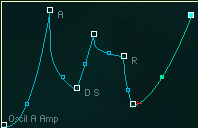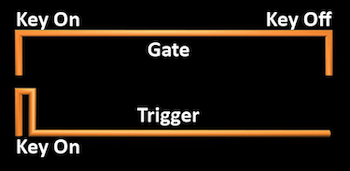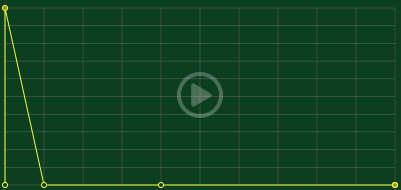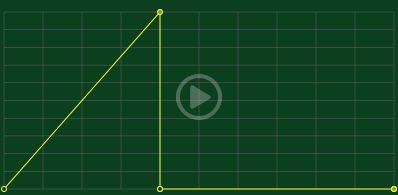Chapter Four: Synthesis

5. Envelopes and Gates
Envelopes
An envelope generator is a module that outputs a single stream of voltage when it is gated or triggered, normally by a keyboard. It outputs a unipolar DC control signal, usually 0 to 5 volts in classic synthesizers. The envelope's voltage is typically applied to a VCF and VCA to control timbre and amplitude over time (including the beginning and ending of a note), but it can also be applied to other modules that accept control voltage such as a VCO to shape pitch over time.

Attack time: the time it takes to rise from 0V to maximum c.v. level (usually +5 volts).If the attack time is set to 0, the note begins at maximum amplitude and goes immediately to the decay phase.
Decay time: after reaching the maximum attack level, the time it takes to decay to a sustain level
Sustain level: the amplitude remains constant until the envelope is ungated (see below), at which point it moves to the release phase.
Release time: The time is take to go from the sustain level back to 0V. If the release time is set to 0, the note ends abruptly.

Modern EG's, particularly graphic EG's in software applications address some of the shortcomings of the classic EG. For example, a classic EG must rise to a maximum voltage no matter what, whereas modern EG's allow partial rise, or even descent for the attack. A classic EG had only four stages with limited shapes, whereas current EG's can have numerous stages and many shapes, including slopes of lines. A classic EG always had a release to 0V, whereas a modern EG can actually have a rise on release, as picture on the left. Pictured is an envelope from Native Instrument's Absynth synth plug-in.
Some classic envelope shapes are shown below. Corresponding sounds were created by applying the same envelope to both filter and amplifier. Click on each image to play example:
In addition to the basic patch connection of EG's to VCO and VCF, envelopes can be effectively used to control pitch over time (often summed with keyboard voltage). A quick down and up divot is often added to brass-like patches, or a fast downward EG gliss to below 20 Hz can make a very interesting percussive sound. EG's can control the depth of modulation over time when used in conjunction with an amplifier (see the FM patch diagram on this page).
What are Gates and Triggers?

How does an envelope generator know when to begin and end its stream of voltage? It traditionally uses a gate. When a key on the keyboard is depressed, not only does the keyboard send control voltage to the oscillator to specify the pitch, but it sends a second type of signal called a gate, to all EG's participating in the note event. When the key is depressed (called Key On) the unipolar pulse begins its positive 5V phase and stays there until the key is released (called Key Off) where the pulse returns to 0V value. The keyboard gate signal is often patched to both the amplitude- and filter-controlling envelope generators. When "gated" by positive voltage (key on), they each move through their attack and decay times to rest at the sustain level until the envelope is "ungated" by 0 volts (key off), at which point they begin their release phase. Sometimes an envelope may not make it to the sustain level before being ungated, at which point it jumps to the release phase from wherever it was, and that may cause a click if the discontinuity is too great.
A keyboard or soft-synth may offer the option for legato note connections. If the user enables legato touch, if there is no time gap between depressed notes or they overlap, the gate will not end, and so the envelope will remain in its sustain mode (or wherever it is in its process). Therefore connected notes will not start a new attack phase and the result will be a legato connection.
A trigger is a short transient pulse, which unlike a gate, has the same brief duration regardless of action, including a key off. Envelopes responding to triggers will skip the sustain phase and immediately go to the release, so are, in effect, ADR's, not ADSR's.
A variation for creating perfectly timed repeated notes would be to apply an LFO (most often set to a pulse wave) to either gate or trigger the envelope. In earlier times, there were dedicated timing pulse generators, sometimes called Pulsers. This was a very popular technique in the 1970's technopop era, used extensively by German "Krautrock" bands such as Kraftwerk, perhaps the technique used in Radio-Activity. A VCO used to provide a gate or trigger could itself be frequency modulated to provide variable or even random rhythms.



